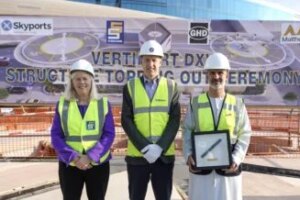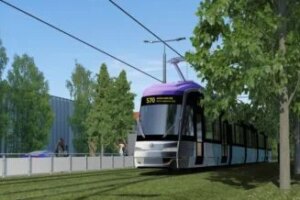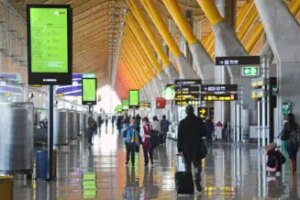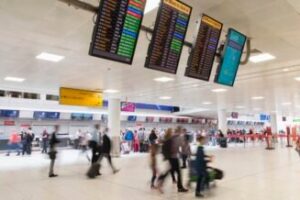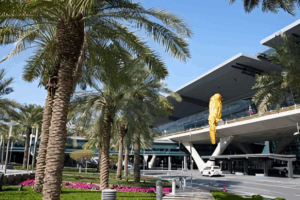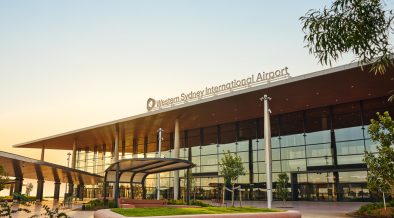
Completion of the construction of the terminal and runway ensures that the countdown is on to the opening of Western Sydney International Airport.
Sydney’s new 24-hour airport is one step closer to welcoming its first passengers, with major construction works across Western Sydney International Airport (WSI) now complete.
Indeed, Australian Prime Minister, Anthony Albanese, and Minister for Infrastructure, Transport, Regional Development and Local Government, Catherine King, as well as senior executives from some of WSl’s key partners joined airport CEO, Simon Hickey, at the new gateway in early June to celebrate the milestone.

Hickey thanked WSl’s design and construction partners that have worked over many years to help bring WSl’s terminal to life from the initial design concepts by COX Architecture and Zaha Hadid Architects to the design and construction by Multiplex and Woods Bagot; with overall project delivery alongside WSI by Bechtel.
He also acknowledged the tremendous efforts of CPB Contractors/ ACCIONA Joint Venture that led works on the Airside Civil and Pavement Works, including WSl’s 3.7km runway, as well as AeroWest, a Joint Venture between BMD Constructions and Seymour Whyte Construction that completed the Landside Civil and Building Works, including the design and construction of car parks, roads, bridges and utilities.

Hickey believes that the terminal design is emblematic of the World Heritage-listed Greater Blue Mountains Area as well as the Cumberland Plain and the region’s incredible First Nations culture and history.
“People will love spending time in this terminal as they enjoy the iconic vistas of the surrounding Blue Mountains that are reflected in our stunning feature ceiling and take in the thoughtful design and materials like the extensive use of beautiful sandstone that was sourced from a quarry on the Central Coast,” he predicted.

“Visitors will be welcomed by the stories of Dharug country that will connect the world with more than 60,000 years of Aboriginal culture while also highlighting the vibrant communities of Western Sydney.”
The terminal has a climate-responsive facade, and more than 6,000 solar panels affixed to its roof to provide energy efficiency and renewable electricity, reducing the airport’s carbon footprint.
In addition, it will collect and recycle rainfall for use in airport operations such as bathrooms, irrigation, and cooling towers.
Passengers flying out of WSI will experience a streamlined departure with access to next generation technology to help them move through the airport at speed, while both domestic and international gates are under one roof, making travellers connections simple and efficient.

While major construction of the WSI terminal is complete, the fit-out of the terminal’s retail precinct and airline lounges will take place closer to the airport’s opening as commercial tenders and final contracts continue to progress over the months ahead.
AIRFIELD EQUIPPED TO HANDLE THE A380
In late May, Hickey described the completion of the airport’s 3.7km runway as a “significant step” in the delivery of the city’s self-proclaimed “24-hour airport”.
The runway, which will be capable of accommodating aircraft up to the size of the A380, was the first significant piece of infrastructure to be completed at the gateway.
He noted: “The work to build our runway and supporting airside facilities has been years in the making – during which workers have literally moved mountains to create a modern, technology-enabled airfield that will soon welcome planes
and passengers.

“Our runway will be equipped with modern technology and our rapid exit taxiways mean WSI’s average taxing time will be around five minutes, significantly shorter compared to other airports around the world, which will get people home and away faster.”
Hickey said there have been millions of work hours put into this critical piece of WSI’s infrastructure with thousands of workers contributing toward the extensive construction project since the bulk earthworks contract was awarded in 2019.
“The site has been transformed to build our 3.7km runway, equipped with approximately 3,000 aeronautical ground lights and 348 high intensity approach lights, which will cater for up to 10 million annual passengers from day one of operations next year.
“Part of our runway certification also involved a Piper PA-30 Twin Engine Comanche aircraft successfully completing multiple take offs and landings on our runway in October last year to ensure the lighting and technology systems were operating effectively.”

The CPB Contractors/ACCIONA Joint Venture led works on the Airside Civil and Pavement Works package (ACP), which was also overseen by WSI’s delivery partner, Bechtel.
Aside from WSI’s runway and lighting, the ACP package also involved the design and construction of the taxiway pavements, aircraft pavement markings, airside roads, surface water drainage, airside security fence and landscaping.
The airport’s newly released inaugural master plan outlines some truly bold ambitions for WSI, which Hickey believes will act as a catalyst for growth and development of the Western Sydney economy.
“Our vision over the next two decades is for WSI to become the gateway of choice to Australia and the world – connecting people, places and opportunities,” he said.
“Beyond the direct A$5.3 billion investment to build the airport, state and federal governments have also invested more than A$17 billion in rail and road infrastructure that’s connecting the west to the west and the west to the rest like we’ve never seen before.
“Greater connectivity enables more job opportunities and business growth. In fact, forecasts indicate investment in NSW will be A$96 billion higher by 2063, with A$85 billion of that increased investment in Western Sydney, due to WSI’s development and its related investments.”
WSI’s inaugural master plan also forecasts 6,000-8,500 airport jobs by the time passenger numbers reach 10 million annually around 2033, presenting meaningful employment opportunities for people living across Western Sydney and beyond.
Growth is certainly on the agenda with WSI expecting to one day become Sydney’s biggest international airport, handling more than 80 million annual passengers, which is akin to London’s Heathrow Airport today.

